This vegan seitan sausage recipe is easy to make and absolutely packed with flavor! The seitan has a firm and chewy texture and its flavors are customizable to your tastes, depending on how you want to use the sausages.
They’re perfect to eat as-is in a bun with your favorite condiments or use them in any recipe like pasta or vegan bangers and mash!
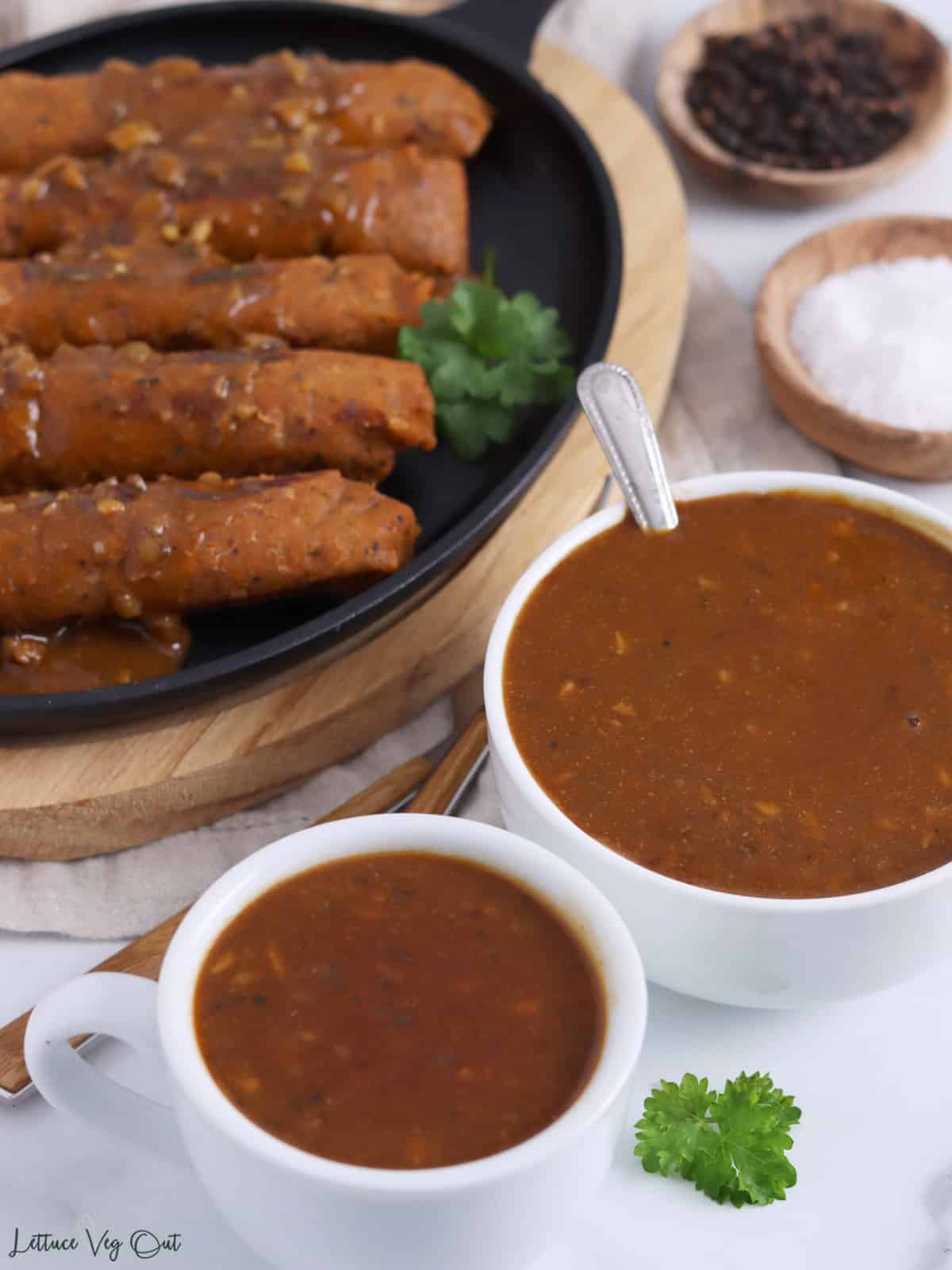
This post contains affiliate links (including Amazon Associates) and I earn from qualifying purchases.
Vegan Ingredients in Seitan Sausage
This recipe has a long list of ingredients, most of which are herbs, spices and other seasonings. A few of the ingredients can be substituted but for the most part, you’ll need the following:
- Olive oil: To create a delicious base layer of flavor, sauté the onions and garlic in some olive oil. This fat is necessary for a moist seitan that isn’t gummy in texture.
- Onion and garlic: These two vegetables add huge amounts of flavor to this recipe, especially as they slowly cook in oil. Small flecks of onion throughout the sausage also helps break up the texture of the seitan (typically quite dense).
- Tomato paste: One of the many liquid seasonings used for this recipe, I love the rich flavor and color that tomato paste provides.
- Soy sauce: For a salty, umami flavor, some soy sauce helps create a flavorful vegan sausage.
- Red wine vinegar: Vinegar enhances the flavor or pretty much anything it’s added to but is especially helpful in seitan recipes to help remove any “wheat” flavor from the gluten flour. Any type of vinegar can work for this recipe, but I like the taste of red wine vinegar.
- Miso paste: Along with soy sauce, miso paste adds a depth of flavor that most other vegan ingredients can’t achieve. It’s salty and packed with umami taste that really helps elevate the seitan sausages to taste “meatier”.
- Chickpeas: The base of many seitan recipes is some type of bean along with gluten flour. Chickpeas are a great, neutral choice when using beans. The fiber content in chickpeas helps break up the gluten, creating a softer seitan that’s still chewy but not spongy or rubbery. Other types of beans (like white beans) should also work.
- Gluten flour: This is the key ingredient in seitan. Also called vital wheat gluten, gluten flour is pure gluten protein and creates the perfect texture for vegan meats. This cannot be replaced with any other type of flour.
- Nutritional yeast: This staple ingredient in my vegan kitchen adds a unique depth of flavor to so many recipes! It has a slightly cheesy, nutty taste and cannot be replaced with any other type of yeast (nutritional yeast is completely different from baking yeast).
- Dry herbs and spices: There’s quite a list of dry herbs and spices for this recipe and they all play a part in creating a delicious vegan sausage. I use dry oregano, paprika (smoked or sweet), salt, black pepper, dry basil, celery seed (fennel seed), dry thyme and dry sage. Adjust the seasoning to your liking and substitute for different herbs or spices if you prefer. If you’re missing one of the herbs or spices, that shouldn’t impact the final flavor too much.
- Red pepper flakes: A final seasoning I like to add to these seitan sausages is hot red pepper flakes. The slight spicy heat helps enhance the other flavors of the dish. You can add these in whole or blend them with the chickpea mixture. Add as much or as little as you like!

How to Make Seitan Sausage
As far as seitan goes, this is an easy recipe to prepare and doesn’t require much kneading (just enough to form the dough).
Step 1: Prepare “Wet” Ingredients
Start by finely mincing onion and garlic. Warm some olive oil in a pan over medium heat and add the onion and garlic.
Cook over medium or medium-low heat for 8-10 minutes until the onions are nice and soft. The onions and garlic may brown a little; lower the heat if they become too dark or start to burn.
Then, add tomato paste, soy sauce, red wine vinegar and miso paste to the pan. Stir until the tomato and miso pastes are dissolved and evenly mixed, then remove the pan from heat.

Drain and rinse your canned chickpeas (or use freshly cooked chickpeas that have been drained and rinsed) and add them to a food processor or small blender.
Add the cooked onion and garlic mixture, scraping out as much of this flavoring as possible.
Blend the chickpeas and onion-garlic mixture until smooth, scraping down the edges of the food processor a couple times.
It’s okay if there’s small flecks of chickpeas that aren’t completely pureed (but try to get the mixture quite smooth).
You can also add the hot red chili flakes to this mixture if you want to blend them in.

Step 2: Mix “Dry” Ingredients and Form Dough
In a large mixing bowl, stir together gluten flour with all remaining dry herbs and spices. This includes nutritional yeast, oregano, paprika, salt, pepper, basil, celery seed, thyme, sage and hot red chili flakes.
Then scrape your chickpea mixture from the food processor into this mixing bowl. Again, make sure to scrape as much as possible out of the food processor.

Stir the mixture until a ball of dough starts to form, then switch to mixing with your hand. Knead the dough by hand until everything is combined and there are no dry bits of gluten flour anywhere.
This is a very firm dough and it takes some work to come together.

Step 3: Shape Sausages and Steam
Cut the seitan into 8 pieces; this recipe makes 8 small sausages. You can cut the dough into 6 pieces for larger sausages, but I find they won’t fit in my steaming basket this way.
Shape each piece of seitan into a sausage by rolling it in your hands (or on a hard surface).
Wrap each sausage in a piece of parchment paper as tightly as possible, then wrap each sausage in a piece of tin foil (again, as tightly as possible).

It’s important for the wrapping to be tight because seitan expands while it cooks. If it has too much room to expand, it creates a spongy texture.
Prep a pot with a steaming basket and add water until the water reaches just below the basket. Fill the pot with wrapped seitan sausages and place a lid on the pot. Bring this to a boil and steam the sausage for 40 minutes.
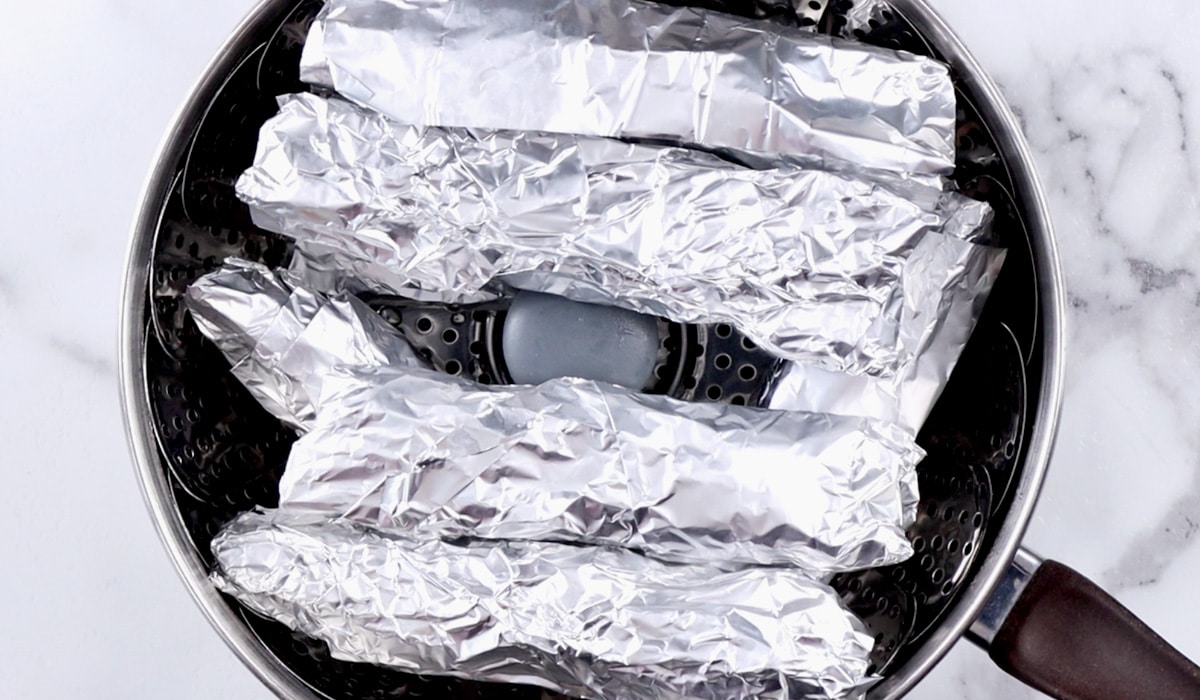
Lower the heat while cooking (down to medium or medium-low) if steam continues to vent from the lid of the pot.
Towards the end of cooking, you may need to add extra water to the pot, so keep an eye on the water level and add in small amounts of water if needed (add hot or boiling water).
Once the 40 minutes have passed, let the sausages cool for at least 10 minutes.
You can serve them right away, but they’ll have the best texture if refrigerated overnight. I like to unwrap each sausage before storing in the fridge to prevent condensation from softening the outer edges.
The next day, reheat your sausages in a frying pan or on a grill/ barbecue. You can also use them in any recipe you like!
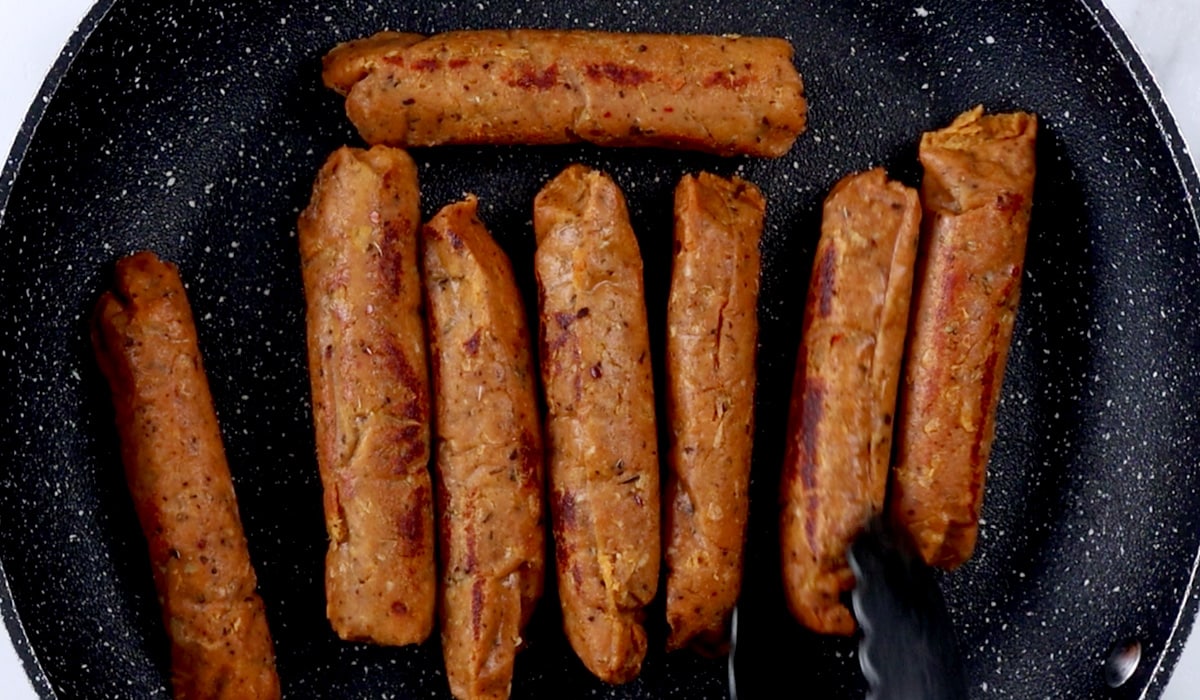
Create a Balanced Vegan Meal with Sausages
I consider a balanced meal one that contains a good source of plant-based protein, carbohydrates, fats and lots of vegetables or fruits.
This recipe is absolutely packed with protein from the gluten flour and chickpeas. It also offers some healthy carbohydrates and fiber along with a small amount of healthy fats.

Seitan sausages are perfect to pair with any vegetable side dish or salad to round out your meal. If you like, add extra carbohydrate options, like potatoes, rice, pasta, bread or a sausage bun for a boost of energy.
These sausages are quite low in fat, especially compared to many store-bought options. While this works for some people, adding extra healthy fats can make the meal more satisfying and satiating.
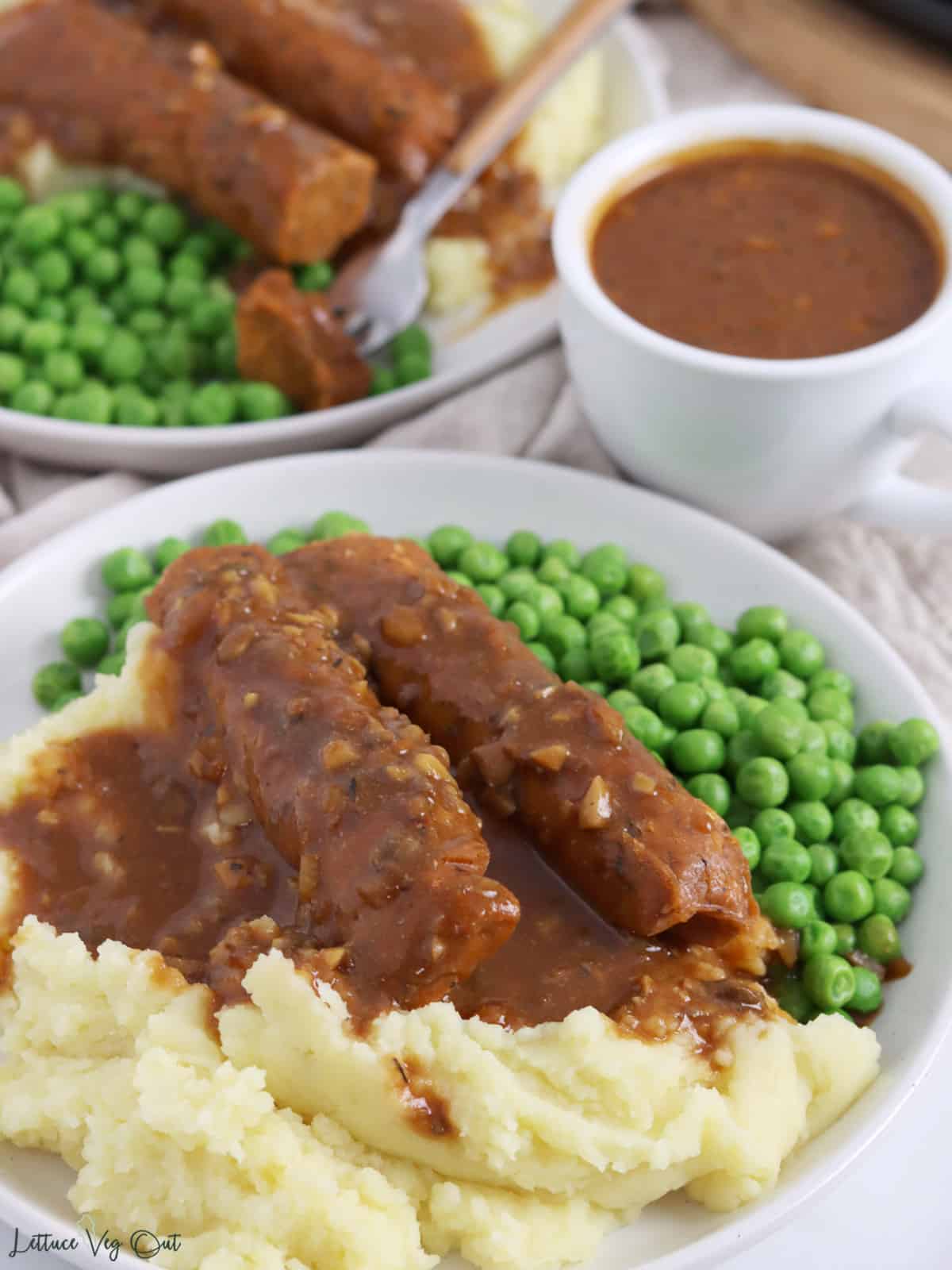
Easy Seitan Variations
Seitan is a delicious, versatile high-protein option for vegans and is great for meal prep. There are endless ways to make seitan, but I typically stick to the easy method used for this sausage recipe.
If you want more variety in your seitan repertoire, check out these other delicious options:
- Vegan ham roast
- Seitan gyros
- Basic seitan roast
- Vegan turkey roast
- Jackfruit seitan “ribs”
- Vegan donair “meat” (like kebab meat)
What to do with Leftover Sausage
Refrigerate any leftover sausages in an airtight container for up to a week. Reheat by pan-frying or grilling/ barbecuing the sausages.
Seitan sausages also freeze well. For freezing, I keep the seitan wrapped. Let them cool to room temperature (or place into fridge to chill), then freeze in a freezer bag or container. They should be okay in the freezer for a few months.
To thaw, place your sausages into the fridge overnight and reheat before eating.

📖 Recipe

Vegan Seitan Sausage
Equipment
- Small pan
- Food processor (or small blender)
- Tin foil
- Steaming basket
- Measuring cups
- Measuring spoons
Ingredients
Vegan Sausage “Wet” Ingredients
- 3 tablespoons olive oil (45 milliliters)
- ½ cup onion , minced (75 grams)
- 3 cloves garlic , minced
- 2 tablespoons tomato paste (30 milliliters)
- 2 tablespoons soy sauce (30 milliliters)
- 2 tablespoons red wine vinegar (30 milliliters)
- 1 tablespoon white miso paste (15 grams)
- 1 cup chickpeas , drained and rinsed (170 grams)
Vegan Sausage “Dry” Ingredients
- 1 ⅛ cup gluten flour (1 cup + 2 tablespoons; 165 grams)*
- 1 tablespoon nutritional yeast
- 1 teaspoon dry oregano
- 1 teaspoon paprika (smoked or sweet)
- ½ teaspoon salt
- ½ teaspoon black pepper
- ½ teaspoon dry basil
- ½ teaspoon celery seed (fennel seed)
- ¼ teaspoon dry thyme
- ¼ teaspoon dry sage
- ¼ teaspoon red pepper flakes , optional
Instructions
Step 1: Prepare “Wet” Ingredients
- Heat olive oil in a small pan over medium heat. Add onion and garlic and cook for 8-10 minutes, until fragrant and soft. If the onions or garlic start to brown, turn the heat to low. Stir regularly while the onions and garlic cook.3 tablespoons olive oil, ½ cup onion, 3 cloves garlic
- Then add tomato paste, soy sauce, red wine vinegar and miso paste. Stir to evenly mix in the ingredients and dissolve the miso. Cook for about 1 minute.2 tablespoons tomato paste, 2 tablespoons soy sauce, 2 tablespoons red wine vinegar, 1 tablespoon white miso paste
- Add drained and rinsed chickpeas to a food processor (or small blender) along with your cooked onion mixture.1 cup chickpeas
- Blend until smooth (small chickpea flecks are okay but it should be as smooth as possible).
Step 2: Mix “Dry” Ingredients and Form Dough
- In a large mixing bowl, whisk gluten flour with the remaining spices.1 ⅛ cup gluten flour, 1 tablespoon nutritional yeast, 1 teaspoon dry oregano, 1 teaspoon paprika, ½ teaspoon salt, ½ teaspoon black pepper, ½ teaspoon dry basil, ½ teaspoon celery seed, ¼ teaspoon dry thyme, ¼ teaspoon dry sage, ¼ teaspoon red pepper flakes
- Scrape the blended chickpea mixture from your food processor into the mixing bowl.
- Stir until a dough starts to form, then switch to using your hand to finish combining. This is a very firm seitan dough, so it takes some work to come together (there are no dry clumps of gluten flour).
Step 3: Shape Sausage and Steam
- Cut the dough into 8 equal pieces and shape each one into a sausage.
- Tightly wrap each sausage in a piece of parchment paper. Then, wrap in a piece of tin foil, again, as tightly as possible.
- Prep a large pot with a steaming basket and fill with water to just below the bottom of the steaming basket.
- Add your sausages to the steaming basket and place a lid on the pot. Boil the water and steam the sausage for 40 minutes. You can lower the heat to medium once the water is boiling (if steam comes out the whole time).
- Keep an eye on the pot to make sure it doesn’t run out of water (add more if needed).
- Once cooked, cool the sausages for at least 10 minutes before serving.
- These are best served the next day, after chilling in your fridge (unwrapped) overnight.
- The sausages can be pan-fried, grilled, eaten as-is or used in any recipe you like.
Notes
Nutrition
More Vegan Main Meal Recipes
Like this recipe? You should also try:

About Nicole Stevens
Nicole is a long-time vegan with a Masters of Science in Food and Nutrition.
She helps people thrive on a vegan diet with balanced recipes.


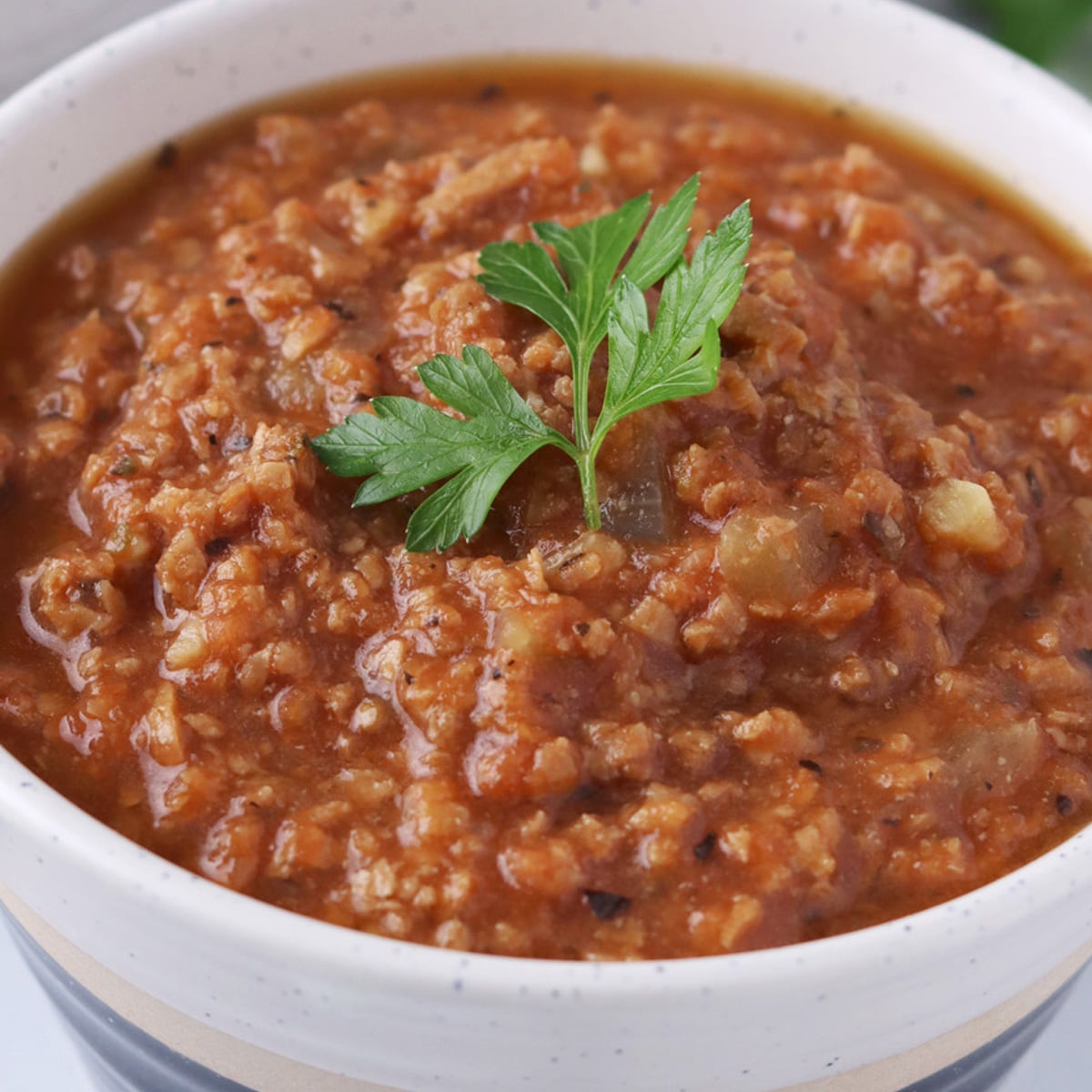
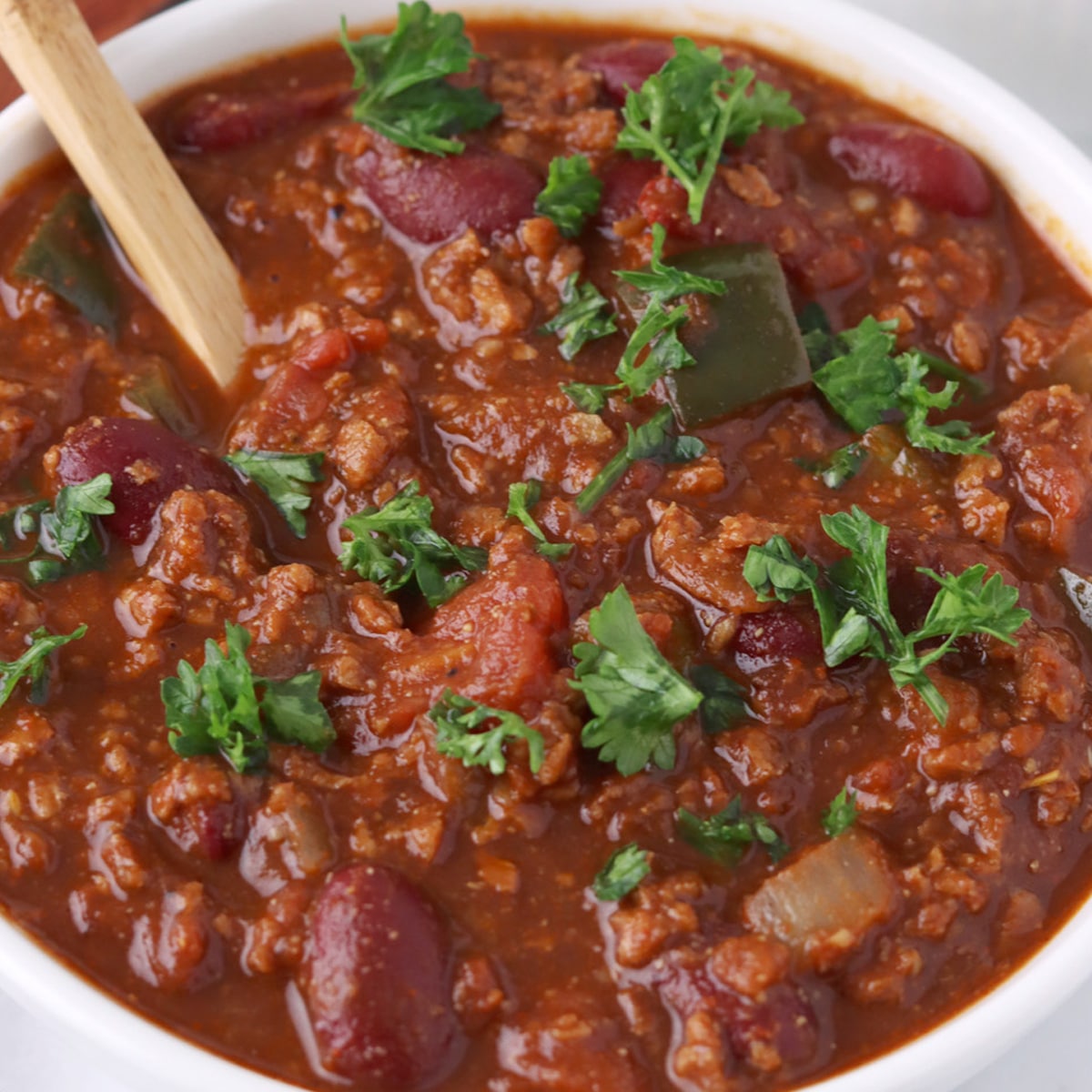
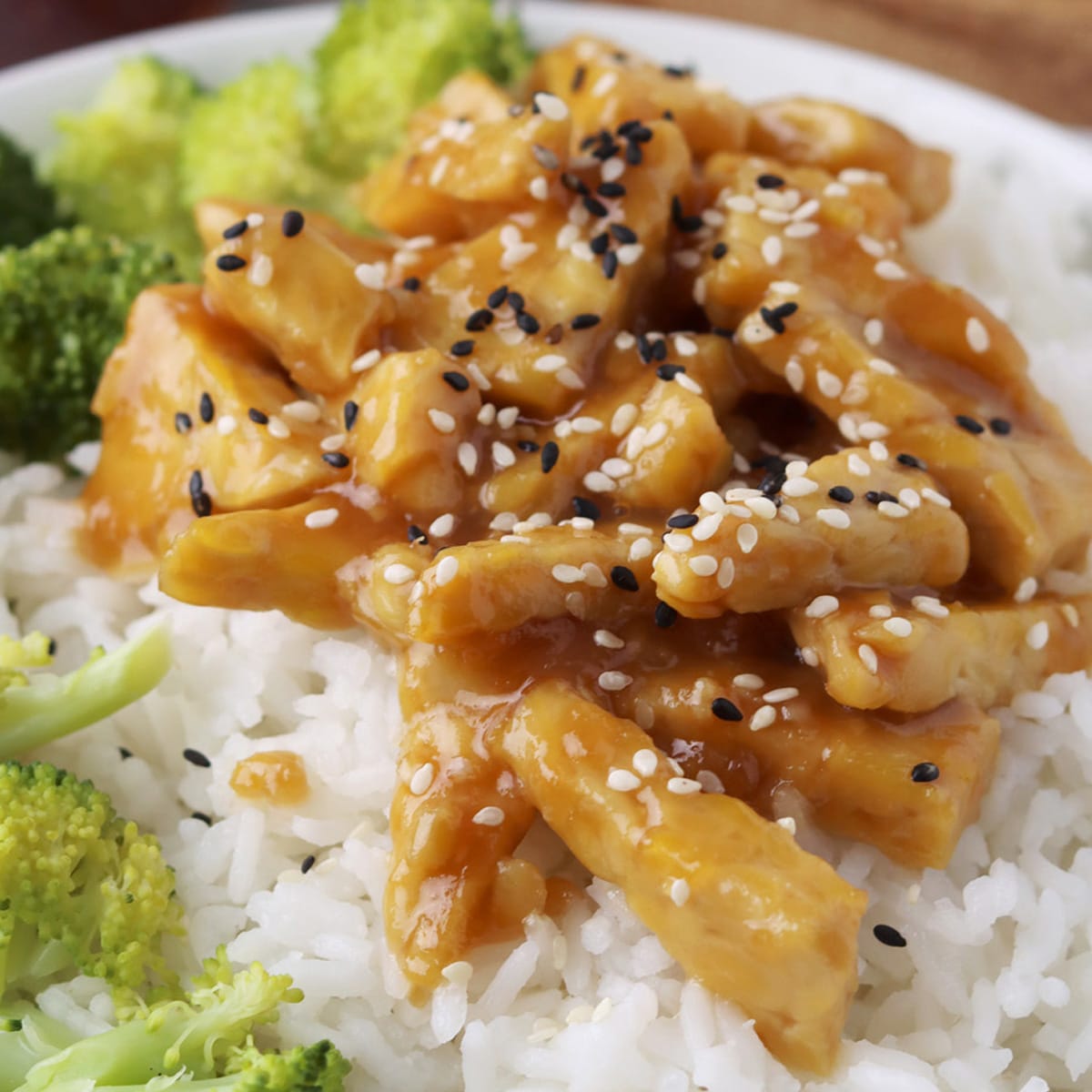

Jan Robertson says
I have a question that isn’t related to your recipe. I want to gradually change my diet to full vegan and have been looking at different vegan cheeses. I didn’t like Daiya and wondered if you have a suggestion?
Nicole says
My current favorite vegan cheese is Violife since it's easy to find where I live. I love Chao as well but haven't seen it in a long time. I've also heard good things about Follow your Heart and Kite Hill but haven't tried those as I've never seen them around. There's tons of other brands available as well and they're getting better all the time!